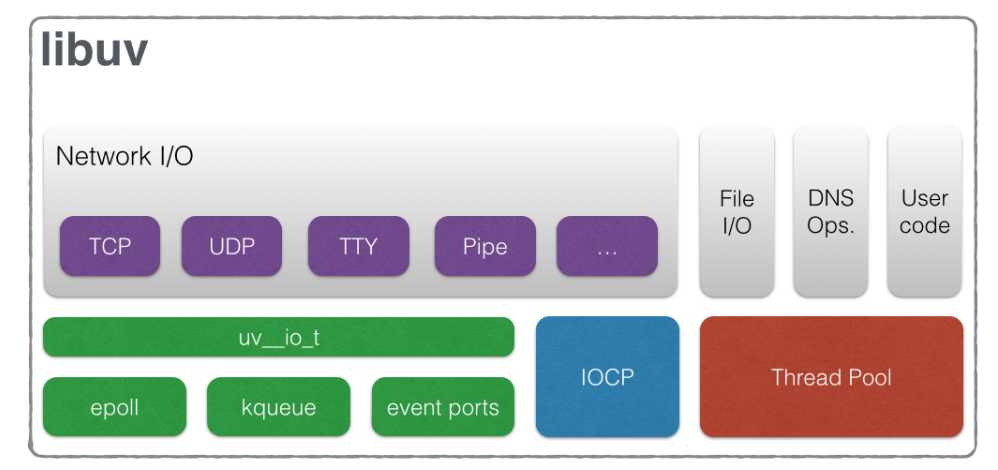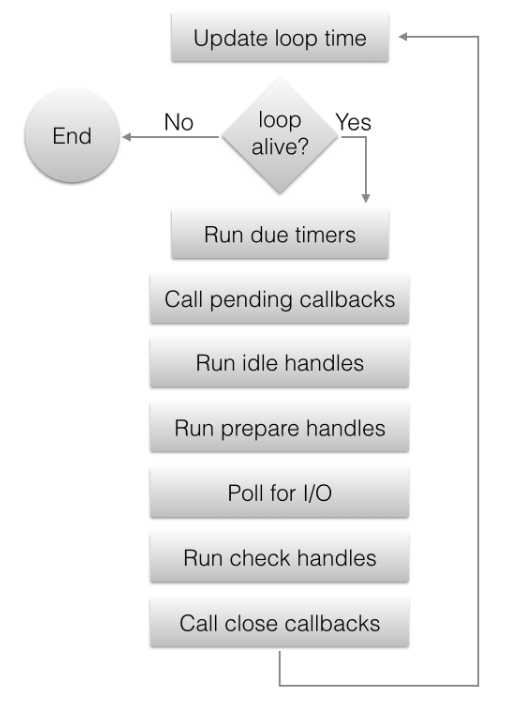标签:
libuv我在今年四月份的开始接触,一开始也遇到了很多坑,但后来理解并遵守了它的设计思想,一切就变得很方便。这几天开始着手精读它的源码,本着记录自己的学习痕迹,也希望能增加别人搜索相关问题结果数的目的,因此就有了这些东西,这个系列至少会有四篇,后续再说吧。
那么它是什么,一个高效轻量的跨平台异步io库,在linux下,它整合了libevent,在windows下,它用iocp重写了一套。它有那些功能,如下面这幅官网上的图所示:

它的整体结构基于事件循环,简单的说就是外部的接口其实是对内层的一个个请求,并没有做真正的事,这些请求都存储在内部一个请求队列中,在事件循环中,再从请求队列中取出他们,然后做具体的事情,做完了利用回调函数通知调用者,这样一来,所有的外部接口都可以变成异步的。
它的世界有三类元素:
它的实现基于一个假设,运行于单线程.
下面主要来分析它的主体和常用部分,循环,timer,tcp,udp,fs,特殊的uv_handle_t.这次分析是基于其windows部分的,因为我在windows上用它比较多,不过其不同平台上的思路是一致的,只是具体实现上采用的系统api不同罢了.库版本基于1.7.0版本.
uv_loop_t
先来看定义,在include/uv.h的1459行:
struct uv_loop_s {
/* User data - use this for whatever. */
void* data;
/* Loop reference counting. */
unsigned int active_handles;
void* handle_queue[2];
void* active_reqs[2];
/* Internal flag to signal loop stop. */
unsigned int stop_flag;
UV_LOOP_PRIVATE_FIELDS
};
#define UV_LOOP_PRIVATE_FIELDS /* The loop‘s I/O completion port */ HANDLE iocp; /* The current time according to the event loop. in msecs. */ uint64_t time; /* Tail of a single-linked circular queue of pending reqs. If the queue */ /* is empty, tail_ is NULL. If there is only one item, */ /* tail_->next_req == tail_ */ uv_req_t* pending_reqs_tail; /* Head of a single-linked list of closed handles */ uv_handle_t* endgame_handles; /* The head of the timers tree */ struct uv_timer_tree_s timers; /* Lists of active loop (prepare / check / idle) watchers */ uv_prepare_t* prepare_handles; uv_check_t* check_handles; uv_idle_t* idle_handles; /* This pointer will refer to the prepare/check/idle handle whose */ /* callback is scheduled to be called next. This is needed to allow */ /* safe removal from one of the lists above while that list being */ /* iterated over. */ uv_prepare_t* next_prepare_handle; uv_check_t* next_check_handle; uv_idle_t* next_idle_handle; /* This handle holds the peer sockets for the fast variant of uv_poll_t */ SOCKET poll_peer_sockets[UV_MSAFD_PROVIDER_COUNT]; /* Counter to keep track of active tcp streams */ unsigned int active_tcp_streams; /* Counter to keep track of active udp streams */ unsigned int active_udp_streams; /* Counter to started timer */ uint64_t timer_counter; /* Threadpool */ void* wq[2]; uv_mutex_t wq_mutex; uv_async_t wq_async;
active_handles是uv_loop_t的引用计数,每投递一个uv_handle_t或uv_req_t都会使其递增,结束一个请求都会使其递减。
handle_queue是uv_handle_t族的队列。
active_queue是uv_req_t族的队列。
data是用户数据域。
uv_prepare_t,uv_check_t,uv_idle_t,uv_async_t是个特殊的uv_handle_t,随后会说明。
pending_reqs_tail是用来装已经处理过的请求的队列。
endgame_handles是用来装执行了关闭的uv_handle_t族链表。
timers是计时器结构,用最小堆实现。
iocp是完成端口的句柄。
这个结构外部除了data外,其他都不应该使用。与其直接有关的接口有两个, uv_loop_init和uv_run。
先来看uv_loop_init,在/src/core.c的126行:
int uv_loop_init(uv_loop_t* loop) {
int err;
/* Initialize libuv itself first */
uv__once_init();
/* Create an I/O completion port */
loop->iocp = CreateIoCompletionPort(INVALID_HANDLE_VALUE, NULL, 0, 1);
if (loop->iocp == NULL)
return uv_translate_sys_error(GetLastError());
/* To prevent uninitialized memory access, loop->time must be initialized
* to zero before calling uv_update_time for the first time.
*/
loop->time = 0;
uv_update_time(loop);
QUEUE_INIT(&loop->wq);
QUEUE_INIT(&loop->handle_queue);
QUEUE_INIT(&loop->active_reqs);
loop->active_handles = 0;
loop->pending_reqs_tail = NULL;
loop->endgame_handles = NULL;
RB_INIT(&loop->timers);
loop->check_handles = NULL;
loop->prepare_handles = NULL;
loop->idle_handles = NULL;
loop->next_prepare_handle = NULL;
loop->next_check_handle = NULL;
loop->next_idle_handle = NULL;
memset(&loop->poll_peer_sockets, 0, sizeof loop->poll_peer_sockets);
loop->active_tcp_streams = 0;
loop->active_udp_streams = 0;
loop->timer_counter = 0;
loop->stop_flag = 0;
err = uv_mutex_init(&loop->wq_mutex);
if (err)
goto fail_mutex_init;
err = uv_async_init(loop, &loop->wq_async, uv__work_done);
if (err)
goto fail_async_init;
uv__handle_unref(&loop->wq_async);
loop->wq_async.flags |= UV__HANDLE_INTERNAL;
return 0;
fail_async_init:
uv_mutex_destroy(&loop->wq_mutex);
fail_mutex_init:
CloseHandle(loop->iocp);
loop->iocp = INVALID_HANDLE_VALUE;
return err;
}
这里初始化了自己各个字段,并用uv__once_init模拟了pthread_once_t初始化了库的各个子系统。
再来看看uv_run,这是核心函数,库的入口与发动机,在src/core.c的372行:
1 int uv_run(uv_loop_t *loop, uv_run_mode mode) {
2 DWORD timeout;
3 int r;
4 int ran_pending;
5 void (*poll)(uv_loop_t* loop, DWORD timeout);
6
7 if (pGetQueuedCompletionStatusEx)
8 poll = &uv_poll_ex;
9 else
10 poll = &uv_poll;
11
12 r = uv__loop_alive(loop);
13 if (!r)
14 uv_update_time(loop);
15
16 while (r != 0 && loop->stop_flag == 0) {
17 uv_update_time(loop);
18 uv_process_timers(loop);
19
20 ran_pending = uv_process_reqs(loop);
21 uv_idle_invoke(loop);
22 uv_prepare_invoke(loop);
23
24 timeout = 0;
25 if ((mode == UV_RUN_ONCE && !ran_pending) || mode == UV_RUN_DEFAULT)
26 timeout = uv_backend_timeout(loop);
27
28 (*poll)(loop, timeout);
29
30 uv_check_invoke(loop);
31 uv_process_endgames(loop);
32
33 if (mode == UV_RUN_ONCE) {
34 /* UV_RUN_ONCE implies forward progress: at least one callback must have
35 * been invoked when it returns. uv__io_poll() can return without doing
36 * I/O (meaning: no callbacks) when its timeout expires - which means we
37 * have pending timers that satisfy the forward progress constraint.
38 *
39 * UV_RUN_NOWAIT makes no guarantees about progress so it‘s omitted from
40 * the check.
41 */
42 uv_process_timers(loop);
43 }
44
45 r = uv__loop_alive(loop);
46 if (mode == UV_RUN_ONCE || mode == UV_RUN_NOWAIT)
47 break;
48 }
49
50 /* The if statement lets the compiler compile it to a conditional store.
51 * Avoids dirtying a cache line.
52 */
53 if (loop->stop_flag != 0)
54 loop->stop_flag = 0;
55
56 return r;
57 }
循环的流程用官方一张图来表示:

这些具体的处理函数也基本是各个子系统的入口函数,在后面分析各个子系统时会详细说明,这里只分析它的三种运行模式,也就是mode参数指定的:
1 int uv_backend_timeout(const uv_loop_t* loop) {
2 if (loop->stop_flag != 0)
3 return 0;
4
5 if (!uv__has_active_handles(loop) && !uv__has_active_reqs(loop))
6 return 0;
7
8 if (loop->pending_reqs_tail)
9 return 0;
10
11 if (loop->endgame_handles)
12 return 0;
13
14 if (loop->idle_handles)
15 return 0;
16
17 return uv__next_timeout(loop);
是这样的,A有任何可处理的请求,返回0.B取最小计时器事件的时间与当前时间的差值。C没有计时器事件返回INFINITE,直到有一个完成端口事件。
最后来说一下uv_loopt_t是如何退出的,A.stop_flag为1.B.没有任何请求(也就是uv_loop_alive的判断)。用uv_stop可以设置stop_flag为1。
未完待续,下一篇讲四大特殊uv_handle_t。
标签:
原文地址:http://www.cnblogs.com/watercoldyi/p/5675180.html